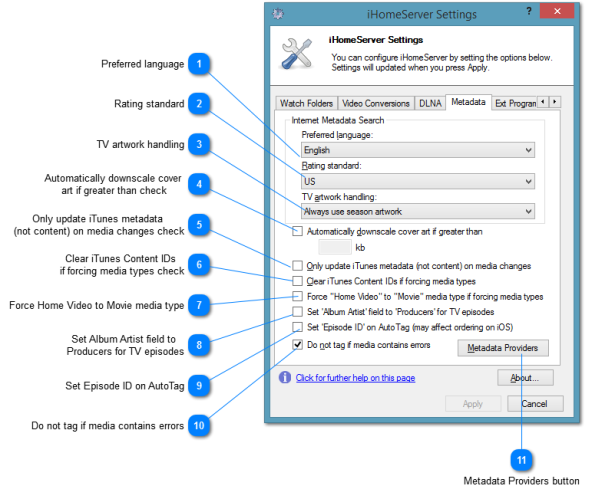|
|
|
||
|
Copyright © 2014 bizmodeller ltd - iHomeServer Release 3.1.46.0 - iHomeServer is a trademark of bizmodeller ltd
|
|
|||||||
|
Copyright © 2014 bizmodeller ltd - iHomeServer Release 3.1.46.0 - iHomeServer is a trademark of bizmodeller ltd
|


The rating standard determines the preferred rating standards that will be used for selecting a 'Content Rating' during an AutoTag operation. The Content Rating is used to set ratings against video media, eg PG13.
|

If artwork that is embedded into a media file is very large, it can take a long time for the image to be downloaded to other devices, such as iOS devices or Apple TVs - this means that when opening your media collection via the Video app or Apple Remote all, your device may appear to hang whilst it downloads artwork.
A prime example of this is if you have no artwork assigned. If no artwork is set on a video file, iTunes will create a frame grab dynamically and will use it as the artwork. This framegrab tends to be huge (multi-Mb) and that is why browsing video files with no artwork is sluggish from within iTunes or other iOS devices via Home Sharing.
iHomeServer can workaround this issue by automatically downscaling any cover art if it is greater than a threshold bytesize that you can define. If the embedded cover art bytesize is greater than the threshold, iHomeServer will generate a downscaled image with a maximum width or height of 1024 pixels (maintaining aspect ratio). This can improve performance on Home Sharing devices.
The default is 'unchecked'
|

If iHomeServer detects a file has changed (due to file size or file dates), it can employ one of two tactics to update iTunes; it can either tell iTunes to fully refresh the file, or it can tell iTunes to update metadata only. The latter is faster than the former. Therefore, by default, iHomeServer will only update the metadata of a file (including artwork) if it detects media changes. There should be no reason to change this default.
|

iHomeServer has an option, that can be configured per Watch Folder, that allows media within a Watch Folder to be set to a specific media type (eg Movie, or TV show) when it is indexed. This option will only work if the content is not protected or purchased; otherwise iTunes blocks the ability to modify the media type.
iHomeServer can work around this by clearing the 'Content ID' metadata field within the file prior to attempting to switch the media type. This field is an internal metadata field that links the media file with an iTunes store reference.
|

Video files contain a metadata tag which determines whether the file is a movie or television episode. Before iTunes 11 was released, by default all media that did not have this flag set was assumed, by iTunes, to be a movie file so most user's media ended up in the Movies tab in iTunes and on your Apple TV.
iTunes 11 onwards introduced a new media type called 'Home Video' which became the new default if this tag was not set. Therefore many users have found that their movies now appear in the Home Videos tab instead of Movies inappropriately.
Unfortunately, once iTunes has imported a file, it never re-reads the tag from the file contents so it's not that easy to recategorise media into the Movies tab by editing the file data. Furthermore, Apple has not extended the iTunes API to support the 'Home Videos' video type so we cannot update media files by calling into iTunes.
Our solution is to switch the media type of a file temporarily to another media type and then switch it back to Movie. This forces iTunes to both categorise the media as a Movie (not a Home Video) and write the updated tag to the file itself. However, this has a performance impact if majority of your files are working ok as it requires two writes to each media file in a watch folder so this behavior is disabled by default but can be enabled by checking this option.
|

Episode ID technically means the internal episode reference provided by the studio. In early versions of iHomeServer, we set this field when AutoTagging metadata if it was provided by the internet metadata source or created one based on the series / episode number if it was not set. Users have reported that some versions of the iPad use the Episode ID to sort TV episodes in preference to the Series / Episode number, therefore we have disabled this option by default. It can be re-enabled by checking this option.
|

Video metadata editing involves modifying the underlying media file. We use a trusted third party library for these calls, however, we have occasionally had reports from users that metadata editing may have corrupted a file.
We always recommend that users make a backup of their media before using iHomeServer, however, in order to minimise the risk of corruption, iHomeServer runs a check of the original media file before making any changes to it. If this check throws up warnings, then by default iHomeServer will not make any subsequent metadata changes to the file. A warning message will be logged in the messages window.
This is quite overzealous in terms of safety however is a safety mechanism to protect your files by default. Many media files to contain errors and iHomeServer can update the metadata in these filese just fine, however, it is difficult to determine which files will work and which files will fail.
If you are finding lots of your files fail because of this safety check, we suggest temporarily disabling it and then testing the metadata updates on some media files for which you have taken a backup
|

This button will display the list of metadata providers that is currently available to iHomeServer. Note that this list may change without notice.
|